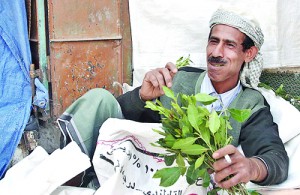Sunday Times 2
Now, Arab-African pleasure leaf khat in Sri Lanka!
A few days ago, a 21-year- old Sri Lankan arriving from Kenya was arrested at the Bandaranaike International Airport by Customs for trying to smuggle into the country 50 kg of “Khat” plants concealed in two bags. Khat is believed to have been brought to be smuggled to Canada.
What is Khat?
The leaves and young shoots of Catha edulis plant are usually referred to as khat. It is a plant native to the horn of Africa and the Arabian Peninsula. It grows in eastern Africa and southern Arabia and more specifically in Yemen, Ethiopia, Kenya, Madagascar, Somalia, and Tanzania.
The leaves of the plant are chewed, (like Sri Lankans chew betel) resulting in the release of stimulants which include cathinone and cathine. Khat (also known as ‘herbal ecstasy’) is chewed for its central nervous system stimulant properties, which resemble

A Yemeni man chewing khat. Pic courtesy Wikimedia Commons
amphetamine.
The habit of khat chewing is widespread with a deep-rooted socio-cultural tradition in countries like Yemen. It poses a public health problem.
Khat leaves are now banned in many countries including Canada, Ireland, Norway, Sweden, Saudi Arabia and the United States but in many others it remains a legal substance.
The leaves and the plant are legal in Britain but cathinone and cathin, two of its active ingredients, are controlled substances.
On March 2, 2006, it was announced in the House of Lords that the government would accept the recommendation of the Advisory Council on the Misuse of Drugs (ACMD) not to make khat itself a controlled substance since it is used by only one or two ethnic groups, mainly the Somali community.
In October 2010, the new government’s Home Secretary, Theresa May, asked the ACMD to look again at khat. The ACMD’s report, published in January 2013, concluded that little had changed since the previous study. If anything, the use of khat in the UK seemed to be declining.
Khat users seek out the freshest plant material, usually the leaves and young shoots, which are chewed to permit absorption of soluble ingredients through mouth and stomach.
The pleasurable, stimulating and euphoric effects obtained following absorption of khat constituents are reported to be similar to the effects of amphetamine and have been considered as a strong inducement for khat users to procure, by any means, the necessary supplies once a day or more frequently to prolong the periods of chewing.
Such behaviour strongly suggests the development of psychic dependence. It is reflected in excessive consumption of khat, with an associated decrease in economic productivity through reduction of working hours because of time spent on chewing khat. In addition, spending on a non-essential commodity at the expense of food has resulted in malnutrition and proneness to disease.
According to the UN Office on Drugs and Crime, a typical chewing session of khat results in the absorption of its active constituents with an activity equivalent to that of about 5 mg of amphetamine.
The pharmacological effects of khat include increased alertness, euphoria, increased body temperature, loss of appetite and increased respiration rate, heart rate and blood pressure. A pregnant woman has developed chest pain, rapid pulse rate and hypertension following a khat-chewing session.
Khat and cancer
Regular khat chewers have inflamed gums and loose teeth, but there appears to be no convincing unusual incidence of oral cancer.Among khat users in Yemen there is, however, a higher incidence of oesophageal cancer compared with gastric cancer.
Deaths associated with the sole consumption of khat have not yet been reported.
Long term use or abuse can cause insomnia, poor appetite, stomach disorders, depression, liver damage and cardiac complications, including heart attacks. Manic and delusional behaviour, violence, suicidal depression, hallucinations, paranoia and khat-induced psychosis have also been reported. On the basis of the scientific data it seems clear that khat use has negative consequences on the economic development of a country and on the health of the society.
Therefore, khat should not be allowed to be smuggled into Sri Lanka. There is a fear that it is already grown here!

